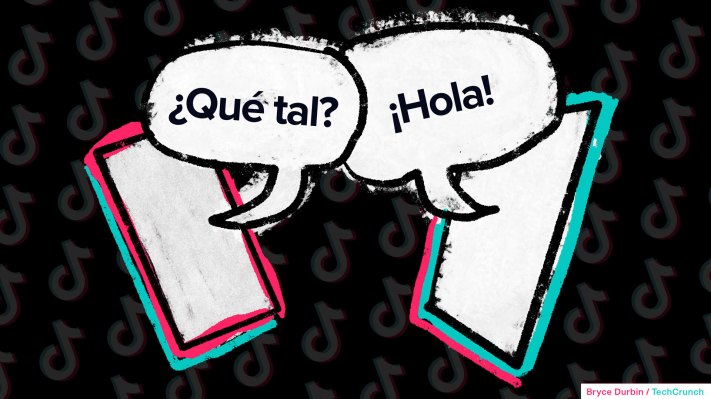Kait Montalvan is a lifestyle and beauty TikToker, but her “get ready with me” videos aren’t standard fare. Like other videos in the “Get Ready With Me” (or GRWM) genre, she’s speaking to the camera about her day while showing how she expertly taps bronzer across her cheeks, wielding a perfectly fluffy brush. It’s not just about the makeup, though. Montalvan is one of a growing cohort of TikTokers who are using these daily mini vlogs to practice speaking Spanish.
“I grew up speaking Spanish when I was much, much younger, probably like three or four. So I actually have videos of myself speaking Spanish. And it’s funny looking back because I’m like, ‘What happened to her?’” Montalvan told TechCrunch.
What happened was that she started going to school, and no longer spent all day under the care of her Spanish-speaking grandmother. Slowly, her comfort speaking Spanish slipped away, and she began identifying as a “no sabo kid,” a term used to refer to Latin Americans who aren’t fluent in Spanish.
“There’s a lot of situations in the Latinx community of not being able to speak Spanish, or whatever native language, because of assimilation,” she explained. “I’m first gen. So a lot of times, when your family comes over [to the U.S.], it’s a matter of assimilating and not wanting to be seen as the odd one out, in kind of a protective mechanism kind of way.”
Montalvan’s experience is common for first-generation Latin Americans, yet there can be a sense of shame that comes along with being a “no sabo kid,” which roughly means “I don’t know” in Spanish. So, Montalvan began posting GRWM videos, which she labels as “going from no sabo kid to lo sé adult.”
“It’s really important for me to reconnect to my Spanish because I feel like it’s such a loss if my grandparents are getting older, and I’m not able to have those dialogues about their lives and their past experiences and carry them on,” she said. “And I want them to know more about me too… Instead of speaking to them in broken Spanish and English, I want to be able to explain in a more full, robust way, instead of feeling like my words and my messages are getting lost in translation.”
Though TikTok may seem an unlikely resource for language learning, it’s quite intuitive. New language learners are often taught to seek out media as an educational supplement, like Spanish soap operas or Japanese anime. But bite-sized TikTok videos are even easier to incorporate into a daily routine, especially when the algorithm catches on to what you’re looking for.
Like Montalvan, lifestyle TikToker Rocio Castro-Videla spoke Spanish as a young child, but she found her Spanish-speaking skills wane as she started going to school and speaking English more often. As an adult, she wants to change that.
“Now that I live in Miami, it made me realize, ‘Wow, I need to practice more,’” she told TechCrunch. “It’s like, 90% of the people here just go straight to speaking Spanish.”
Castro-Videla also practices her Spanish by making Spanish language GRWM videos, but she’s also found that as she engages with more Spanish-speaking content, the TikTok algorithm surfaces it even more. It’s a passive way of ensuring immersion in the language.
“I get a lot of stuff from Spain, Puerto Rico, Argentina, and all of these things in Spanish, and I really love watching them because you get a glimpse into other people’s culture,” she said. “Everyone’s Spanish is so different, so I feel like it’s cool to see everyone’s approach.”
When practicing a language, TikTok can offer an easy way to see how native speakers talk, whereas more traditional educational resources can skew rigid. And TikTok has a cultural norm of adding captions to videos, which allows viewers to both hear and read what a creator is saying at the same time.
“I think [TikTok] is more conversational,” Montalvan said. “It’s more similar to the kinds of conversations or dialects of Spanish that you would actually hear in use in real life, as opposed to a telenovela soap opera, which tend to be more dramatized and more formal.”
While watching telenovelas can be an entertaining way to practice listening skills, social media can generate community. Castro-Videla has been posting Spanish videos since May, and over time, other people who are learning Spanish found her account.
“I actually have had some people start following me because of these Spanish videos, and they’re asking me to do more videos in Spanish, because they either like listening to it and watching it, or they feel inspired to also practice on their own,” she said. “So it’s been kind of cool to see how I can influence other people, and how I’ve been influenced by others too.”
Like Montalvan, Castro-Videla sees Spanish as an important link to her relatives and heritage.
“My entire family, except for my parents and sisters, live in Argentina and only speak Spanish,” she told TechCrunch. “That means I need to stay on top of my Spanish-speaking abilities to keep a relationship with them.”
But while language can be integral to maintaining personal relationships, Montalvan is eager to point out that speaking Spanish and being Latinx are not one in the same.
“I think what I realized is that my ability to speak Spanish or how I speak my Spanish doesn’t define my connection to my culture,” said Montalvan. “I think that’s just a good reminder for anyone on this journey.”
